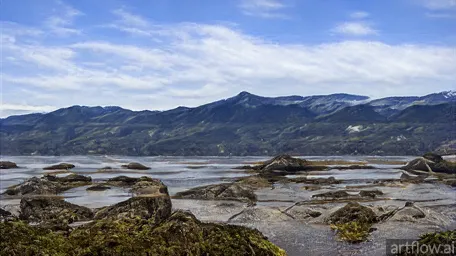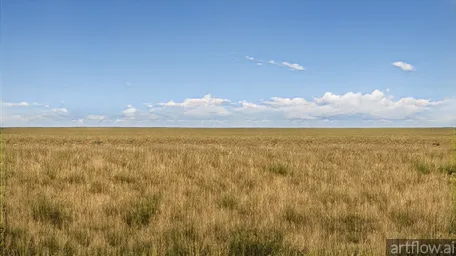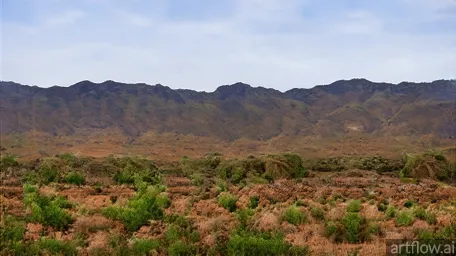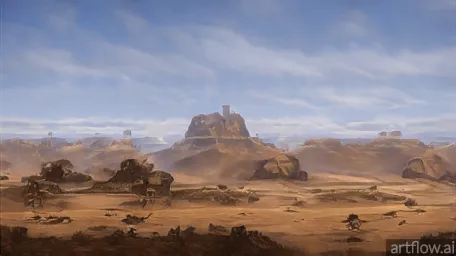The Shan
The Shan spread as long as our lives. It is an extension of ourselves and we live through its immensity. Our bodies are made of the desert's dust, for as we chose the Shan we are part of it.
Continental Expanse
The Shan Desert is one of the two continents of R'habali. It is an arid desert of dust and rocks, covered by sparse vegetation dried by the two burning suns of the planet. With superficies of little less than 20 million km², all of the continent is not a desert. The arid land is still most of it, though. The rest is mainly mountains and plains.
The Coast
The continent is surrounded by tall mountains. Reaching as high as 8216 metres, the mountain range draws almost perfectly the coastline, except in the West. By some geological whim, the oceanic plates do not subdue nicely under the monstrous continental plate that forms the Shan. Instead, they ram straight into it, rising up mountains that never seem to fall down. This phenomenon does not seem to be ancient on a geological timescale, and xenogeologists can only surmise the fate of such a formation. If it is to last, the mountains rise even higher, but at the same time, the added weight might ultimately make the coastline crumble.
The oceanic climate is blocked by the mountains that are lush with life and vegetation on one side and dry inside the land. Numerous plant and animal species have adapted to life on a thin stretch of land between ground and sea, and most life there is amphibian. The intertidal zone is abundant with semi-aquatic plants, more than anywhere else on the planet. Due to the tall mountains, this ecosystem never meddles with the other side of the ridge, to the point they share very few traits.

The west plains
Only one side of the continent is not closed off from the ocean by high peaks. On the west, the air of the ocean pervades the land for several hundred kilometres, bringing some freshness. The area, on a thousand square kilometres, is lush with life. It is closed to the desert by a great canyon, only linked by two stone bridges. Grazing animals are numerous in the plains, and so are predators. The tall grass plays provide a great advantage to ambush predators who are predominant.
Exchanges are rare between the plains and the desert, except for birds who prefer to nest in the huge trunks of the plain trees while hunting the small desert mice. This biome's ecosystem shares some of its origins with the coastal biome, as many animals have vestigial swimming appendages despite being entirely grounded.

The desert
The Shan desert occupies the greatest part of the continent. Only small bushes and dust covers the rocky ground, with few mountains here and there. The landscape is monotonous and barren, save for the few species that manage to survive. The glistening suns heat the region for the 16 hours of a day. When they are both high in the sky, the few shadowy places are fought over and the foothills suddenly become crowded.
The underground is filled with deep phreatic tables that only come up in a handful of places, making a dozen great oases and several hundred that are no more than sources. The smaller sources often dry up and others appear, balancing their numbers at all times. The vegetation blooms around the oases, with tall trees projecting a welcomed shadow. Anywhere else, only the plants with the deepest roots can dream of reaching the water. Sr'hor'hej bushes are the most commonly found and also the harder to get rid of. Despite reaching no more than 70 centimetres on the surface, its roots can run for kilometres to find water.
Although there is not much point of interest besides the oases, hills and ancient mountains are pretty common. In the northernmost part of the continent, the surrounding range turns into a massif. The treacherous environment hides strange critters and natural wonders such as the flowing mountain.
Shantiahe
The Shan desert is home to a nomad civilisation, the Shantiahe. Shut off in the arid land, they spread on the whole continent except for the plains. Their culture forbids them from crossing the stone bridges as they believe the land beyond is the realm of the dead, where the souls of the deceased go when their time has come. Some live close to the mountain range, unaware of the ocean that is sometimes less than a dozen kilometres away. These people are either shepherds of the placid R'haltene that are used for their meat and leather, or hunter-gatherers tracking down the undomesticable beasts of the Shan.





Comments